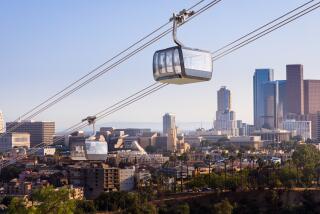Column: Stan Kroenke ready to show NFL owners detailed Inglewood stadium plans
Stan Kroenke won’t be empty handed this week when he arrives at the NFL owners meetings in Arizona.
The St. Louis Rams owner will be packing finished schematic plans for the world’s most interactive and integrated football stadium, a futuristic, $1.86-billion, privately financed venue proposed for the Hollywood Park site in Inglewood.
Kroenke is not quite ready to put a shovel in the ground, but the major pieces of the project are now fully drawn, allowing the global sports and real estate billionaire to show the small army of architects and engineers at his disposal have made significant progress.
Representatives of Kroenke and HKS, the architecture firm he’s employed, met with the Los Angeles Times recently in San Francisco to provide a first look at the detailed plans.
The timing of the meeting — days before the NFL convenes Monday at the Arizona Biltmore resort — wasn’t coincidental. The league’s owners will ultimately decide when and where the nation’s No. 1 sport returns to its No. 2 market.
The San Diego Chargers and Oakland Raiders entered the running last month, announcing a joint proposal to build a stadium in Carson. Kroenke hasn’t said he plans to move the Rams, but his intentions seem clear — analysts say it’s highly doubtful he would invest in a stadium and not use it for his own team.
Any NFL franchise that wants to move would need the support of three-quarters of the league’s 32 owners in a vote. It’s unlikely any such vote will take place before the fall, as St. Louis, San Diego and Oakland continue trying to convince their teams to stay put. The league has already said no team would be allowed to move before next season.
The latest renderings show a light metallic, wave-shaped structure featuring a roof that encompasses the stadium and a surrounding plaza, providing weather protection but remaining open on the sides. The stadium could host big indoor events such as a college basketball Final Four.
The roof has metal borders, but the area over the playing field is made of a transparent material called ETFE, which is as clear as a car windshield and strong enough to support the weight of a vehicle. The design allows for breezes to flow through the building, enhancing the outdoor feel.
“This stadium grows out of the DNA of the region,” said Mark Williams, director of sports and entertainment business development for HKS, which designed AT&T Stadium for the Dallas Cowboys and Lucas Oil Stadium for the Indianapolis Colts.
While the roof of the Inglewood stadium would be 275 feet above the playing field, the building would be set into the ground, giving it an above-ground profile of 175 feet, considerably lower than most enclosed stadiums. The proposed venue conforms to the height restrictions imposed on buildings within close proximity to Los Angeles International Airport, and the stadium designers say it also makes for a more attractive neighbor.
“So many stadiums are a big building that’s out in a field somewhere,” said Chris Meany, senior vice president of the Hollywood Park Land Co. “Very few have been integrated into the community.”
Los Angeles has seen impressive renderings before, but hasn’t had an NFL football team since 1994. Over the last two decades, several developers have unveiled all kinds of dazzling drawings and slick video presentations of venues that never came to pass.
What makes Kroenke different is that he is an NFL owner, and the league’s second-richest owner at that. His team also has a deep and nostalgic connection to L.A., and he — along with development partner San Francisco-based Stockbridge Capital Group — has nearly 300 acres of prime stadium land the league itself tried to buy.
HKS estimates the Inglewood project would take less than three years to build, and the first round of construction permits could be obtained by December. Any team relocating here probably would play at the Coliseum or Rose Bowl during the building process.
HKS and its consultants are moving into the design development and construction documentation stages of the project. In essence, the group has basic designs in place, including the various building components such as plumbing and air conditioning, and is now onto developing the detailed building plans.
Big-screen advertising
Why does a Southern California stadium need a roof? Aside from the fact an enclosed venue can play host to a wider range of events, a covering gives Kroenke the ability to create the world’s biggest billboard, one visible to the more than 35 million travelers who fly into and out of L.A. each year. Images or animations could be projected onto the roof, instead of being permanent fixtures. Plans call for a sail-shaped roof structure that’s twice as big as the stadium and shelters the football field, the adjacent 6,000-seat performing arts venue and the “Champions Plaza” in between. HKS is studying perforated metal panels and the mottled shadow patterns those cast on the ground like sunlight through a tree. The playing surface would be artificial turf.
Built to share
Kroenke doesn’t need to partner with another team to finance the stadium, but the NFL sees L.A. as a two-team market and wants venues to be capable of hosting both. The Inglewood plan is two-team compliant, which means it has two home locker rooms, identical sets of office space, and two owners’ suites. Whereas the Carson proposal is based on the Chargers and Raiders simultaneously relocating, it is widely believed Kroenke does not want to share the market with another NFL team right away, and, because he would be assuming the risk of the stadium by himself, would want to reap the benefits of getting his team up and running as L.A.’s sole franchise.
All sides approach
HKS describes the stadium as “four-sided,” which means the venue is accessible and approachable to the public from 360 degrees. There would be no fenced-off areas at ground level such as loading docks, mechanical yards, dumpsters and the like. That would all be below ground and accessible via tunnels located near the stadium. VIP, event-level parking could also be accessed through the tunnels. Counting the underground and surface parking, 9,000 spaces would be dedicated to the stadium alone, with others in the nearby office and retail buildings. Backers of the Inglewood stadium estimate they would need a total of about 21,000 spaces for an NFL game, and say there would be roughly 45,000 spaces within a mile of the stadium on game days.
More to Read
Get our high school sports newsletter
Prep Rally is devoted to the SoCal high school sports experience, bringing you scores, stories and a behind-the-scenes look at what makes prep sports so popular.
You may occasionally receive promotional content from the Los Angeles Times.






